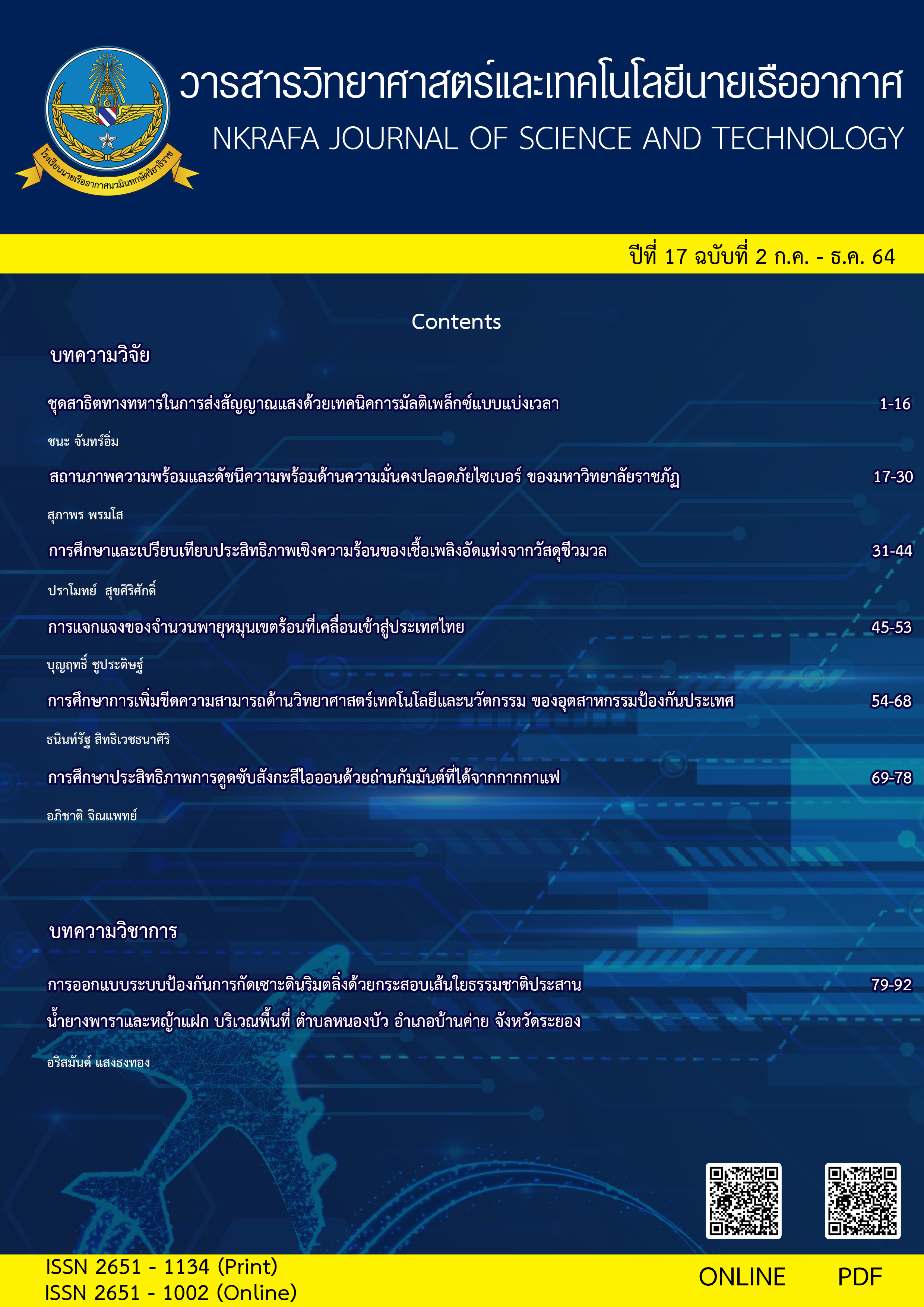Cybersecurity Readiness and Index of Rajabhat University
Main Article Content
Abstract
This study aims to study and analyze 1) the problems of cybersecurity in Rajabhat University, 2) obstacles affecting the development of personnel cybersecurity competency, 3) personnel readiness in cybersecurity of Rajabhat University and 4) to develop a model for cybersecurity readiness. A qualitative research method was performed in this study. Twenty-five experts were selected for in-depth semi-structured interview, including a focus group that approach to achieve cybersecurity problems, obstacles and cybersecurity readiness index of Rajabhat University, prior to the content analysis was done. The analysis of results concluded that the cybersecurity problems of Rajabhat University include: problems with cybersecurity measures, determination of organizational policy, personnel problems, and attack problems. The obstacles affected to develop personal’s competencies of Rajabhat University are as follows: executive policy, knowledge skill, organizational culture and instability of network systems. In terms of readiness condition and cybersecurity readiness index of Rajabhat University, this study introduced a cybersecurity readiness model which comprised of system standard, infrastructure adjustment, digital technology utilization, personnel potential development, cybersecurity competency and cybersecurity transformation. In addition, the cybersecurity readiness index, contained 7 main factors and 24 sub-factors.
Article Details

This work is licensed under a Creative Commons Attribution-NonCommercial-NoDerivatives 4.0 International License.
- Content and information in articles published in NKRAFA Journal of Science and Technology are comment and responsibility of authors of articles directly. Journal editorial do no need to agree or share any responsibility.
- NKRAFA Journal of Science and Technology Articles holds the copyright of the content, pictures, images etc. which published in it. If any person or agency require to reuse all or some part of articles, the permission must be obtained from the NKRAFA Journal of Science and Technology.
References
Dutta, S., Geiger, T. and Lanvin, B. (2015). The global information technology report 2015: ICTs for inclusive growth. Geneva: World Economic Forum.
แผนพัฒนาดิจิทัลเพื่อเศรษฐกิจและสังคม, กระทรวงเทคโนโลยีสารสนเทศและการสื่อสาร. (2559). แผนพัฒนารัฐบาลดิจิทัลของประเทศไทย ระยะ 3 ปี พ.ศ. 2559-2561.
Irfan, M., Putra, S. J., & Ramdhani, M. A. (2019, March). The readiness model of information technology implementation among universities in Indonesia. In Journal of Physics: Conference Series (Vol. 1175, No. 1, p. 012267). IOP Publishing.
Narwal, B., Mohapatra, A. K., & Usmani, K. A. (2019). Towards a taxonomy of cyber threats against target applications. Journal of Statistics and Management Systems, 22(2), 301-325.
Assenza, G., Faramondi, L., Oliva, G., & Setola, R. (2020). Cyber threats for operational technologies. International Journal of System of Systems Engineering, 10(2), 128-142.
Sapienza, A., Ernala, S. K., Bessi, A., Lerman, K., & Ferrara, E. (2018, April). Discover: Mining online chatter for emerging cyber threats. In Companion Proceedings of the The Web Conference 2018 (pp. 983-990).
ThaiCERT ETDA. (2018). สถิติภัยคุกคาม.สืบค้น 23 มกราคม 2563, จากThaicert.or.th/statistic 2018.html.
สำนักงานส่งเสริมการค้าในต่างประเทศ ณ กรุงเฮก ประเทศเนเธอร์แลนด์. (2017). ความปลอดภัยทางไซเบอร์.สืบค้น 23 มกราคม 2563 จากhttps://www.ditp.go.th/contents_attach/207952/207952.pdf.
Bahuguna, A., Bisht, R. K., & Pande, J. (2019). Assessing Cybersecurity maturity of organizations: An empirical investigation in the Indian context. Information Security Journal: A Global Perspective, 28(6), 164-177.
Lehto, M. (2018). Cybersecurity Education and Research in the Finland's Universities and Universities of Applied Sciences. In Cybersecurity and Threats: Concepts, Methodologies, Tools, and Applications (pp. 248-267). IGI Global.
Fatokun, F. B., Hamid, S., Norman, A., & Fatokun, J. O. (2019, December). The impact of age, gender, and educational level on the Cybersecurity behaviors of tertiary institution students: An empirical investigation on Malaysian universities. In Journal of Physics: Conference Series (Vol. 1339, No. 1, p. 012098). IOP Publishing.
คณะกรรมการจัดทำพจนานุกรมศัพท์คอมพิวเตอร์และเทคโนโลยีสารสนเทศ. มติเมื่อ 28 มิถุนายน 2562, สำนักงานราชบัณฑิตยสภา.
ศิวลีย์ ศิริโรจน์บริรักษ์. (2015).การพัฒนามาตรฐานการรักษาความมั่นคงปลอดภัยไซเบอร์ (Cybersecurity) ของกระทรวงกลาโหมม,วารสารสถาบันวิชาการป้องกันประเทศ. ปีที่6 ฉบับที่ 3 พฤษภาคม-สิงหาคม 2558.หน้า 21.
ยุทธนา เจียมตระการ. (2561). การจัดการความมั่นคงปลอดภัยไซเบอร์สำหรับอุตสาหกรรมขนาดใหญ่.(รายงานวิจัยตามหลักสูตรการป้องกันราชอาณาจักร รุ่นที่ 60, วิทยาลัยป้องกันราชอาณาจักร).
ราชกิจจานุเบกษา. (2562). พระราชบัญญัติการรักษาความมั่นคงปลอดภัยไซเบอร์ พ.ศ. 2562.
กิตติ โฆษะวิสุทธิ์, ธาวินี วงศ์วิศว์, กิติศักดิ์ จิร วรรณกูล, ปิลัญญา เชิญถนอมวงศ์ และชญานิน แก้วหาญ. (2564). ศูนย์ประสานงานความมั่นคงปลอดภัยเทคโนโลยีสารสนเทศภาคการธนาคาร. สมาคมธนาคารไทย, นนทบุรี. 78 หน้า.
จิรประภา อัครบวร. (2549). สร้างคนสร้างผลงาน. กรุงเทพมหานคร: ก.พลพิมพ์ (1996).
อนันต์ นามทองต้น. (2554). มองทางลัดสู่การปฏิบัติที่เป็นเลิศ. พิมพ์ครั้งที่ 3. นนทบุรี: สหมิตร พริ้นติ้งแอนพับลิสซิ่ง.
ณรงค์เวตย์ เรืองจวง. (2561). แนวทางการพัฒนาขีดความสามารถบุคลากรด้านไซเบอร์ของกองทัพอากาศ. รัฏฐาภิรักษ์, 60 (3): 22-33.
S. Cheang. (2009). Conceptual Model for Cybersecurity Readiness Assessment for Public Institutions in Developing Country: Cambodia. 4th International Conference on Computer Sciences and Convergence Information Technology.
Wendy and W. Gunawan. (2019). Measuring information security and Cybersecurity on private cloud computing. Journal of Theoretical and Applied Information Technology, 96 (1): 156-168.
Obi, T., and Iwasaki, N. (2015). The Waseda University E-Government Rankings. IOS Press.
Global Cybersecurity Index (2015). The Global Cybersecurity Index and Cyber Wellness Profiles Report. International Telecommunication Union and ABI Research. สืบค้นจาก http://www.itu.int/dms_pub/itu-d/opb/str/D-STR-SECU-2015- PDF-E.pdf.
สำนักงานรัฐบาลอิเล็กทรอนิกส์ (องค์กรมหาชน). 2559 . Global Cybersecurity Index. International Telecommunication Union (ITU), https://www.dga.or.th/wp-content/uploads/2021/ 02/7.pdf, online.


